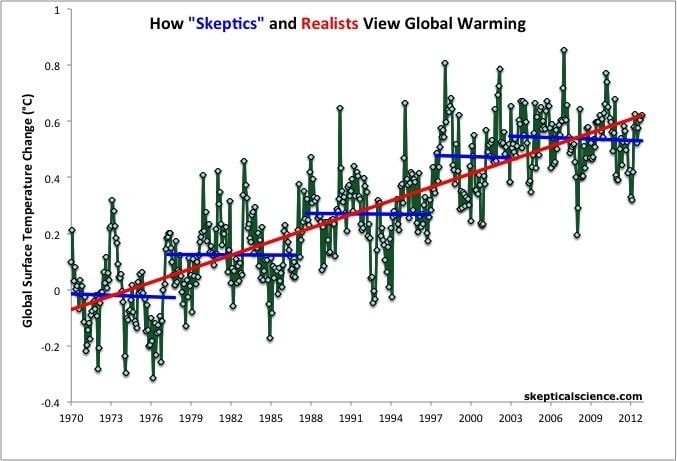The global warming “hiatus”
By Dawn Stover | September 23, 2014

If humans are causing climate change by burning fossil fuels that pollute the atmosphere with carbon dioxide, creating a greenhouse effect that decreases the amount of heat radiating from the Earth into space, why haven’t global temperatures risen in lockstep with carbon dioxide increases during the past 15 years or so? The notion that global warming has gone on “hiatus” is the most popular and persistent myth that climate skeptics and their adherents have asserted (and asserted) in recent years.
Since about 2000, atmospheric temperatures have indeed increased at a slower pace than they rose in preceding decades. Nonetheless, measurements of air temperatures at many locations on the Earth’s surface show that the trend remains upward, toward a warming planet. The summer that just ended was the planet’s hottest on record. The year 2014 is also shaping up to be one of the hottest in history.
A joint overview issued in February 2014 by the UK’s Royal Society and the US National Academy of Sciences makes the point clearly. Analyzing millions of measurements from around the world is a complicated business, the overview notes, but “multiple independent teams have concluded separately and unanimously that global average surface air temperature has risen by about 0.8 degrees Celsius since 1900. Although the record shows several pauses and accelerations in the increasing trend, each of the last three decades has been warmer than any other decade in the instrumental record since 1850.”
So how can climate skeptics claim that the Earth is in the midst of a global warming “pause” or even a “decade-long cooling,” as did one recent headline from the conservative think tank known as the Heartland Institute? Two words: cherry picking. Skeptics choose a couple of arbitrary data points—a temperature reading from early 2000 and another from early 2010, for example—and highlight a temperature drop between them. Because 1998 was a particularly hot year, it often serves as a convenient starting point for skeptics, who point to a slowdown in warming in subsequent years. But the mercury did not actually stop rising: 17 of the last 18 years have been among the hottest on record, according to NOAA’s National Climatic Data Center. What looks like a slowdown is merely one statistical cherry that climate change deniers have picked because it suggests a downward path. But the deniers seldom deal with the scientific reality of the so-called hiatus: It is a short fluctuation in a long-term upward trend in atmospheric temperatures.
Also, skeptics sometimes choose arbitrary locations when making claims about a hiatus. The central and eastern United States, for example, have been cooler than average this year—but they are the among the very few land areas on the planet that bucked the trend of rising temperature. Skeptics also tend to overlook the many other observed indications of a globally warming climate, such as retreating glaciers worldwide, shrinking Arctic sea ice, diminishing ice sheets on Greenland and Antarctica, and accelerating global mean sea-level rise.
The atmosphere stores very little heat, so factors such as solar activity, volcanic eruptions, and natural modes of climate variability such as the Pacific Decadal Oscillation can affect year-to-year air temperature measurements. The oceans absorb more than 90 percent of the heat that the greenhouse effect is adding to the planetary system, and ocean winds and currents affect the rate at which heat penetrates. If winds increase the transfer of heat from surface waters to deeper ocean layers, for example, they could increase the amount of heat absorbed into seawater overall, slowing the rate of warming of air near the planet’s surface. Scientists have documented a long-term warming of the ocean’s upper layers, but they have relatively few measurements that could help them determine the full details of how the heat content of the entire global ocean has changed in recent decades.
Although much remains to be learned about the many physical processes involved in the slowdown in the global rate of atmospheric warming over the last 10 to 15 years, the vast majority of climate scientists do agree on this: Despite a slower rate of warming in the 2000 to 2010 period, the decade as a whole was warmer than the 1990s, and a temporary slowdown in the warming of air near the Earth’s surface does not invalidate scientists’ understanding of the long-term global warming that is occurring as a result of human activities.
Together, we make the world safer.
The Bulletin elevates expert voices above the noise. But as an independent nonprofit organization, our operations depend on the support of readers like you. Help us continue to deliver quality journalism that holds leaders accountable. Your support of our work at any level is important. In return, we promise our coverage will be understandable, influential, vigilant, solution-oriented, and fair-minded. Together we can make a difference.
Topics: Climate Change, Explain This














